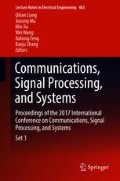Abstract
The development of 5G wireless communication systems are changing the daily life. Both transmission speed and Quality of Service (QoS) are developing fast. However, the increasing demand of data traffic brought about the number of base stations, which lead to the additional consumption of system power. Therefore, some of the power consumption is unnecessary by achieving same system performance. In this work, we discuss the resource allocation method in different policies to reduce energy consumption without losing the performance. Both theoretic and system level results are given in this work.
Access this chapter
Tax calculation will be finalised at checkout
Purchases are for personal use only
References
Meywerk, F.: The Mobile Broadband Vision–How to Make LTE a Success. LTE World Summit, London (2008)
Richter, F., Fehske, A.J., Fettweis, G.P.: Energy efficiency aspects of base station deployment strategies for cellular networks. In: Proceedings of the IEEE Vehicular Technology Conference (VTC 2009-Fall), pp. 1–5 (2009)
POSTnote: ICT and CO2 Emissions, Parliamentary Office of Science and Technology, December 2008. http://www.parliament.uk/documents/post/postpn319.pdf
Imran, M.A., et al.: Energy efficiency analysis of the reference systems, areas of improvements and target breakdown. Technical report. Energy Aware Radio and Network Technologies, Brussels, Belgium (2011)
Chen, Y., Zhang, S., Xu, S., et al.: Fundamental trade-offs on green wireless networks. IEEE Commun. Mag. 49(6), 30–37 (2011)
Gruber, M., Blume, O., Ferling, D., et al.: EARTH—energy aware radio and network technologies. In: 20th International Symposium on Personal, Indoor and Mobile Radio Communications, pp. 1–5 (2009)
Zhou, S., Zhao, T., Niu, Z., Zhou, S.: Software-defined hyper-cellular architecture for green and elastic wireless access. IEEE Commun. Mag. 54(1), 12–19 (2016)
Cai, S., Che, Y., Duan, L., et al.: Green 5G heterogeneous networks through dynamic small-cell operation. IEEE J. Sel. Areas Commun. 34(5), 1103–1115 (2016)
He, Q., Xiao, L., Zhong, X., et al.: Increasing the sum-throughput of cells with a sectorization method for massive MIMO. IEEE Commun. Lett. 18(10), 1827–1830 (2014)
Bi, W., Su, X., Xiao, L., et al.: On rate region analysis of full-duplex cellular system with inter-user interference cancellation. In: IEEE International Conference on Communication Workshop (ICCW), pp. 1166–1171 (2015)
Gao, Y., Li, Y., Yu, H., et al.: Energy efficient cooperative sleep control using small cell for wireless networks. Int. J. Distrib. Sens. Netw., 10–20 (2015)
He, G., Zhang, S., Chen, Y., et al.: Architecture design and performance evaluation for future green small cell wireless networks. In: IEEE International Conference Communications Workshops (ICC), pp. 1178–1182 (2013)
Zhang, S., Xu, X., Lu, L., et al.: Sparse code multiple access: an energy efficient uplink approach for 5G wireless systems. In: IEEE Global Communications Conference (GLOBECOM), pp. 4782–4787 (2014)
Wang, L., Xu, X., Wu, Y., et al.: Sparse code multiple access-towards massive connectivity and low latency 5G communications. Telecommun. Netw. Technol. 5, 5 (2015)
Wang, Y., Zhou, S., Xiao, L., et al.: Sparse Bayesian learning based user detection and channel estimation for SCMA uplink systems. In: IEEE International Conference on Wireless Communications and Signal Processing (WCSP), pp. 1–5 (2015)
Lian, J., Zhou, S., Zhang, X., et al.: Low complexity decoding method for SCMA in uplink random access. In: IEEE Global Communications Conference (GLOBECOM), pp. 1–6 (2016)
Jia, M., Gu, X., Guo, Q., Xiang, W., Zhang, N.: Broadband hybrid satellite-terrestrial communication systems based on cognitive radio towards 5G. IEEE Wirel. Commun. 23(6), 96–106 (2016)
Jia, M., Wang, X., Gu, X., Guo, Q.: A simplified multiband sampling and detection method based on MWC structure for Mm wave communications in 5G wireless networks. Int. J. Antennas Propag. 2015, 10 (2015). https://doi.org/10.1155/2015/873673. Article ID 873673
Jia, M., Wang, L., Yin, Z., Guo, Q., Gu, X.: A novel spread slotted ALOHA based on cognitive radio for satellite communications system. EURASIP J. Wirel. Commun. Netw. 2016(50), 1–9 (2016)
Gao, Y., et al.: Review of wireless big data in 5G: from physical layer to application layer. In: 2016 2nd IEEE International Conference on Computer and Communications (ICCC), Chengdu, pp. 23–27 (2016)
Acknowledgement
This work is funded by China’s 973 project under grant of 2012CB316002 and China’s 863 project under grant of 2013AA013603, National Natural Science Foundation of China (61201192), International Science and Technology Cooperation Program (2012DFG12010); National S & T Major Project (2013ZX03001024-004), Operation Agreement between Tsinghua University and Ericsson, Qualcomm Innovation Fellowship. The work of Su Hu was jointly supported by the MOST Program of International S&T Cooperation (Grant No. 2016YFE0123200), National Natural Science Foundation of China (Grant No. 61471100/61101090/61571082), Science and Technology on Electronic Information Control Laboratory (Grant No. 6142105040103) and Fundamental Research Funds for the Central Universities (Grant No. ZYGX2015J012/ZYGX2014Z005). We would like to thank all the reviewers for their kind suggestions to this work.
Author information
Authors and Affiliations
Corresponding author
Editor information
Editors and Affiliations
Rights and permissions
Copyright information
© 2019 Springer Nature Singapore Pte Ltd.
About this paper
Cite this paper
Gao, Y. et al. (2019). Energy Oriented Resource Allocation in Heterogeneous 5G Networks. In: Liang, Q., Mu, J., Jia, M., Wang, W., Feng, X., Zhang, B. (eds) Communications, Signal Processing, and Systems. CSPS 2017. Lecture Notes in Electrical Engineering, vol 463. Springer, Singapore. https://doi.org/10.1007/978-981-10-6571-2_25
Download citation
DOI: https://doi.org/10.1007/978-981-10-6571-2_25
Published:
Publisher Name: Springer, Singapore
Print ISBN: 978-981-10-6570-5
Online ISBN: 978-981-10-6571-2
eBook Packages: EngineeringEngineering (R0)

